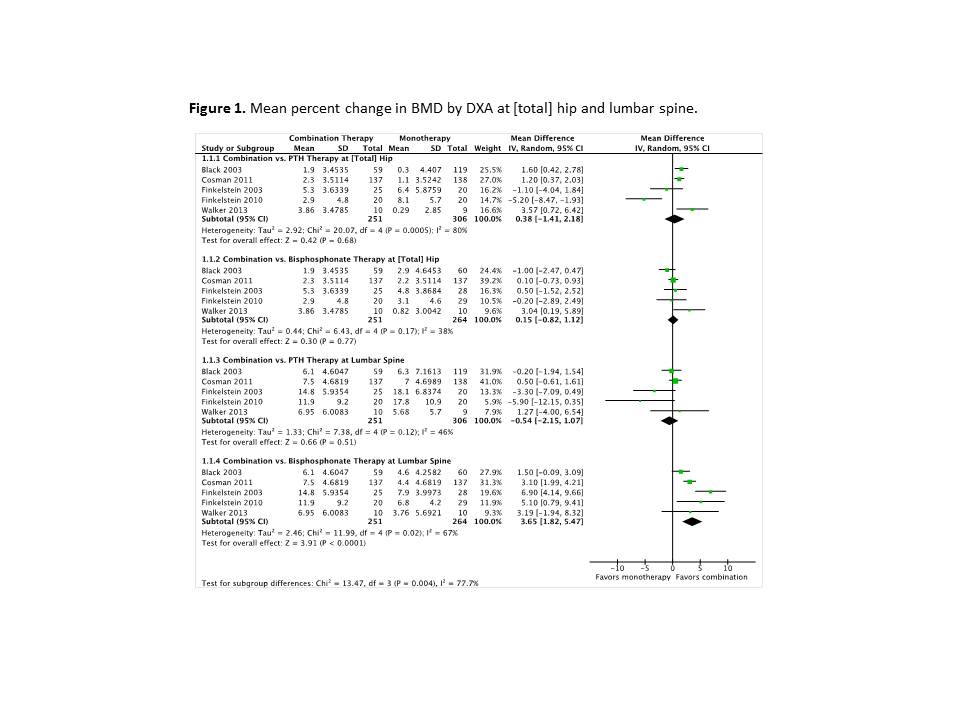Session Information
Session Type: Abstract Submissions (ACR)
Background/Purpose:
Bisphosphonates are currently the drug of choice for treatment of osteoporosis. While anabolic agents like parathyroid hormone (PTH) have shown greater improvements in bone mineral density (BMD) in severe osteoporosis, their use is limited to a maximum of 2 years due to risk of osteosarcoma with rapid loss of gained BMD after cessation of treatment. Given the limits of both agents, we want to assess the effects of PTH and bisphosphonate combination therapy versus monotherapy with either agent on BMD in patients with osteoporosis.
Methods:
We searched MEDLINE, the Cochrane Library, and ClinicalTrials.gov from inception to October 2013. We also reviewed reference lists of included studies and searched the abstracts of the last four years of relevant scientific meetings. We included randomized trials comparing combination therapy with bisphosphonate and PTH versus monotherapy with either agent in men and post-menopausal women with osteoporosis followed for at least 3 months. Studies had to report mean change in BMD as measured by dual-energy X-ray absorptiometry (DEXA) at either the total hip or lumbar spine. Data collection and analysis was done by at least two reviewers independently collected data from each study using a standardized form. We used random effects models to calculate pooled weighted mean differences (WMD) and relative risks (RR).
Results:
Of 332 studies identified, six met all inclusion criteria. Combination therapy led to small increases in % change in BMD at the total hip compared to PTH alone (WMD 0.38, 95% CI -1.41 to 2.18, I2=80%, 5 studies) and bisphosphonate alone (WMD 0.15, 95% CI -0.82 to 1.12, I2=38%, 5 studies). Similarly, combination therapy resulted in larger increases in % change in BMD at the spine compared to bisphosphonate alone (WMD 3.65, 95% CI 1.82 to 5.47, I2=67%, 5 studies), however PTH alone was superior to combination therapy at the lumbar spine (WMD -0.54, 95% CI -2.15 to 1.07, I2=46%, 5 studies). Based on 6 studies, there was a significant risk in developing hypercalcemia with combination therapy compared to monotherapy (11.83% vs. 7.04%, RR 1.68, 95% CI 1.18 to 2.41).
Conclusion:
Combination therapy with PTH and bisphosphonates leads to greater improvements in BMD only at the lumbar spine compared to bisphosphonate therapy alone, however at the cost of increased risk of hypercalcemia.
Disclosure:
Z. Kulcsar,
None;
L. Saleh,
None;
S. Gangidi,
None;
P. Khadka,
None.
« Back to 2014 ACR/ARHP Annual Meeting
ACR Meeting Abstracts - https://acrabstracts.org/abstract/a-meta-anlaysis-of-bisphosphonate-and-parathyroid-hormone-pth-use-in-osteoporosis/

